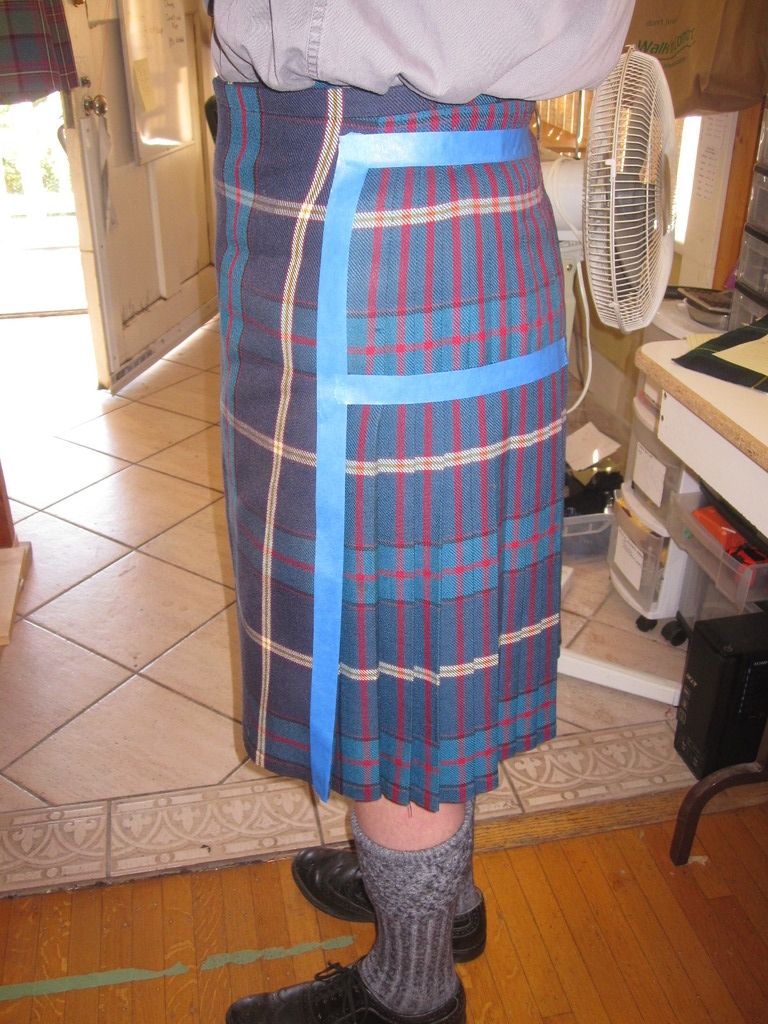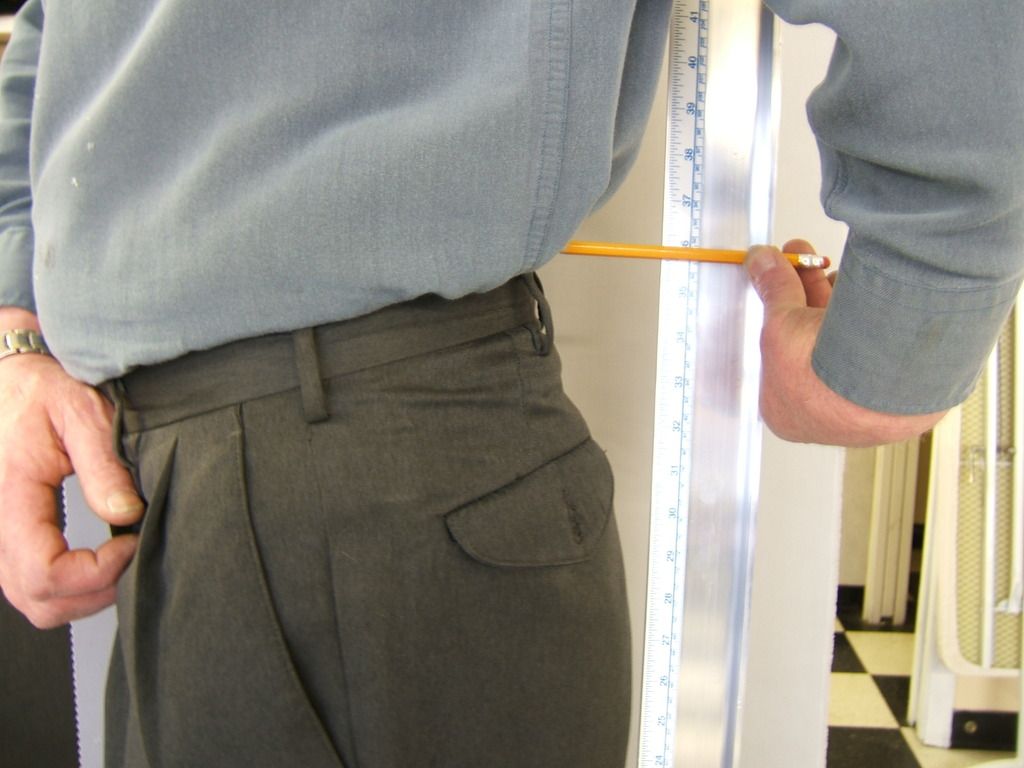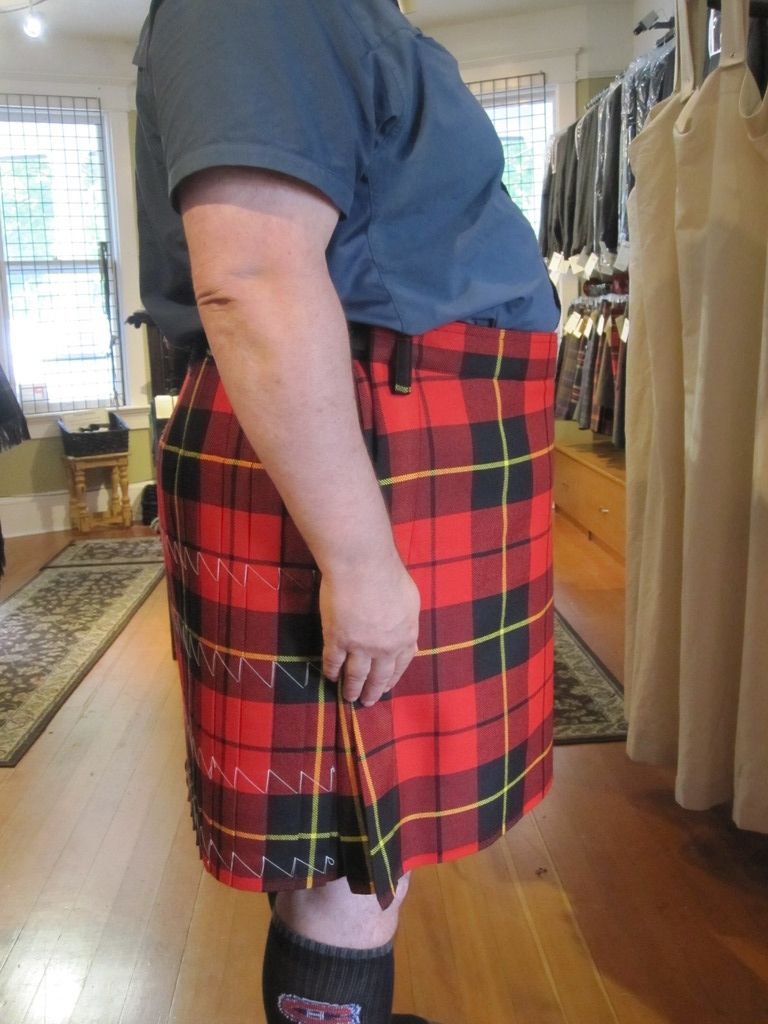|
-
28th June 16, 07:47 AM
#1
Question regarding making a Kilt when the Waist is larger than Hips
I have been asked to make a kilt for a man with a 53 inch waist and 49 inch hips. I know what it says in the Art of Kiltmaking regarding this situation. I just wondered if you have any other tips that aren't in the book. Any information will be greatly appreciated.
-
-
28th June 16, 08:19 AM
#2
When someone has a waist this big, a kilt looks best if it hangs straight down from the waist while at the same time snugging in a bit in the small of the back (i.e., having tapered pleats), because, even when someone has a belly, the buttocks will stick out in the back farther than the small of the back. TAoK suggests making the waist and hips the same when the waist is bigger than the hips (i.e., for your guy, 53 waist and 53 hips). Unfortunately, this doesn't allow any taper in the pleats and produces a kilt that is likely to look like a tilted cylinder, with the pleats not hanging straight down the side of the kilt (see photo below).


I've found that the solution is to add to the hip measurement in excess of the waist measurement (i.e., not make them equal). Below, you'll see the same guy in a kilt made with a hip measurement big enough to allow the apron to hang straight down from the waist. Not only does the kilt look better, but the guy looks slimmer!!

So, how much to add? The simplest way to figure this out is to roll a towel and put it under the belly to kind of fill the space. Be sure it's not sticking out past the belly, and don't wrap it around to the side. Measure around the hips again but around the towel in front as well. Then split the new hip measurement evenly with half the measurement in the apron and half in the pleats. This works well for any guy with a belly - doesn't have to be just for guys whose waists are bigger than their hips.
For some guys, I've had to add as much as 5-6" to the actual hip measurement to get the apron to hang straight in the front and have the pleats nicely snugged in to the small of the back.
Last edited by Barb T; 29th June 17 at 10:54 AM.
-
The Following User Says 'Aye' to Barb T For This Useful Post:
-
28th June 16, 10:00 AM
#3
This is great, Barb. Many thanks. One more question, if I may. Is there anything different about placing the hip strap/buckle after measuring using this method?
-
-
28th June 16, 10:13 AM
#4
If you use one, you should put it on at the hip measurement you made the kilt to. But honestly? I would try to talk a guy out of a hip buckle if he had a large waist. In any event, what you do not want to do is put the buckle on where he could buckle it so that the apron pulled in under his belly (hence why you want to put the buckle on at the over-large hip measurement that you used for the kilt).
-
-
28th June 16, 10:20 AM
#5
 Originally Posted by Barb T

If you use one, you should put it on at the hip measurement you made the kilt to. But honestly? I would try to talk a guy out of a hip buckle if he had a large waist. In any event, what you do not want to do is put the buckle on where he could buckle it so that the apron pulled in under his belly (hence why you want to put the buckle on at the over-large hip measurement that you used for the kilt).
Thanks, Barb. I thought it would be like this. I just wanted to be sure. I'd rather ask the question now than ask after I've messed up. Thanks again.
-
-
28th June 16, 10:23 AM
#6
-
-
28th June 16, 10:50 AM
#7
I have also found it helpful when measuring kilts for guys like this to take two additional measurements as a backup.
Barb has already pointed out -
The aprons are made from a flat piece of fabric and hang straight down from the belly. All the shape of the kilt is in the rear.
Well, the apron edges are flared and if you will look at the third photo Barb posted above you should be able to see that the apron edge hangs straight down.
What I do is measure across the back - at the waist - from apron edge to apron edge.
Then
Measure across the back - at the hips - from apron edge to apron edge.

The difference between these two is the amount you need to taper the Fell.
If you do not have a kilt to take these two additional measurements you can use the side seam of a pair of trousers or even a door frame or other vertical edge. Just something to give you a vertical reference.
These two additional measurements do not need to be perfect. They are a back up or confirmation of the measurements you got using the pillow/towel method.
Steve Ashton
www.freedomkilts.com
Skype (webcam enabled) thewizardofbc
I wear the kilt because: Swish + Swagger = Swoon.
-
-
28th June 16, 02:16 PM
#8
Thank you so much for this information.
I'm dealing with this exact problem at the moment. It will be a plain coloured wool or drill kilt (thankfully no plaid to worry about) I haven't cut anything at the moment. I had used the search function and learnt about "gut cut" and other terms but I wasn't happy with that solution as it would look awful on the gentleman. I'm waiting to get hold of him for a new set of measurements and I shall use this method. (Hopefully I can convince him to wear it at his waist not at his jeans waist)
Extra question... Is this method suitable for a more casual a box pleat kilt as well?
-
-
28th June 16, 02:57 PM
#9
 Originally Posted by Lady Grey

Is this method suitable for a more casual a box pleat kilt as well?
Doesn't matter what kind of a trad kilt you're making - box, Kingussie, Reverse Kingussie, knife - the fit is still the same. The only thing different is the kind of pleats. All four styles still have a rise, an apron, and pleats, and there's a fell in the pleats. So, yes, both the method I described above and the one that Steve describes are applicable.
-
-
28th June 16, 03:48 PM
#10
What Barb says is true - for traditional style kilts.
But - if you run across a customer who wishes to wear their kilt at anywhere but full rise you may run into a bit of a problem.
The Full Rise we associate with a traditional style kilt is really high in comparison with anything else a man today has ever worn. It is up at kidney level. The top straps cinch in right under the ribs and the Rise portion of the kilt rides up on the ribs. In the back the top of the kilt covers the short ribs. In the front it is about 3 or 4 finger widths below the breastbone.
I spent quite a bit of time looking at anatomy and guys shapes when I first began my kiltmaking because I started out making solid colored kilts worn lower than full rise.
You can see in this photo that the waistband of a pair of trousers fit lower in the front than in the rear. (And this pair of trousers is made to be worn higher than blue jeans.)

What I noticed is that guys who have a traditional kilt but wear it lower have a problem. What I call "Slope". Not only does shirt show between the top of the kilt and the bottom of a Prince Charlie Coatee and the hem is below the knee cap, but there will also be a large pucker in the front aprons.
So I chose to put Slope in my kilts to account for this. Now, Slope is different that the so called "Beer Gut Cut" introduced by the Utilikilt Co. Utilikilts would just cut away a large arc in the front of the kilt.
Slope may be cut lower in the front but is usually also cut higher in the back. As an example - I don't have much of a belly but I like to wear my kilts at "Mid Rise". Or with the waistband on top of my hips. My personal kilts are made 3/4" higher in the back and 3/4" lower in the front for a total difference of 1 1/2".
Here is an extreme example of a Tartan kilt with Slope. The hem is horizontal and all the pleats hang vertically. (OK the apron edge kicks out but that is due to a wrinkle when we hung it in the closet. It came right out with a shot of steam.)
This kilt is being worn at mid rise. When we first measured the guy we accounted for his stomach but we backed up the measurements with the split measuring system I describe above.

Just a note of clarification - The Wallace Tartan kilt above is not a Traditional style kilt. This idea of fitting a garment to the body shape and desires of the customer was the whole idea why I invented the Contemporary style of kilt.
The above kilt is designed to be worn lower than Full Rise.
It is machine sewn.
It has a waistband similar to that found on trousers.
It is made from a Polyester/Rayon blend fabric.
And it has pockets.
All of the above could have been different such as Full Rise, Hand-Stitched, 16oz wool, and still have been a Contemporary style kilt.
Last edited by Steve Ashton; 28th June 16 at 05:08 PM.
Steve Ashton
www.freedomkilts.com
Skype (webcam enabled) thewizardofbc
I wear the kilt because: Swish + Swagger = Swoon.
-
 Posting Permissions
Posting Permissions
- You may not post new threads
- You may not post replies
- You may not post attachments
- You may not edit your posts
-
Forum Rules
|
|






















Bookmarks